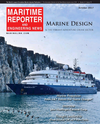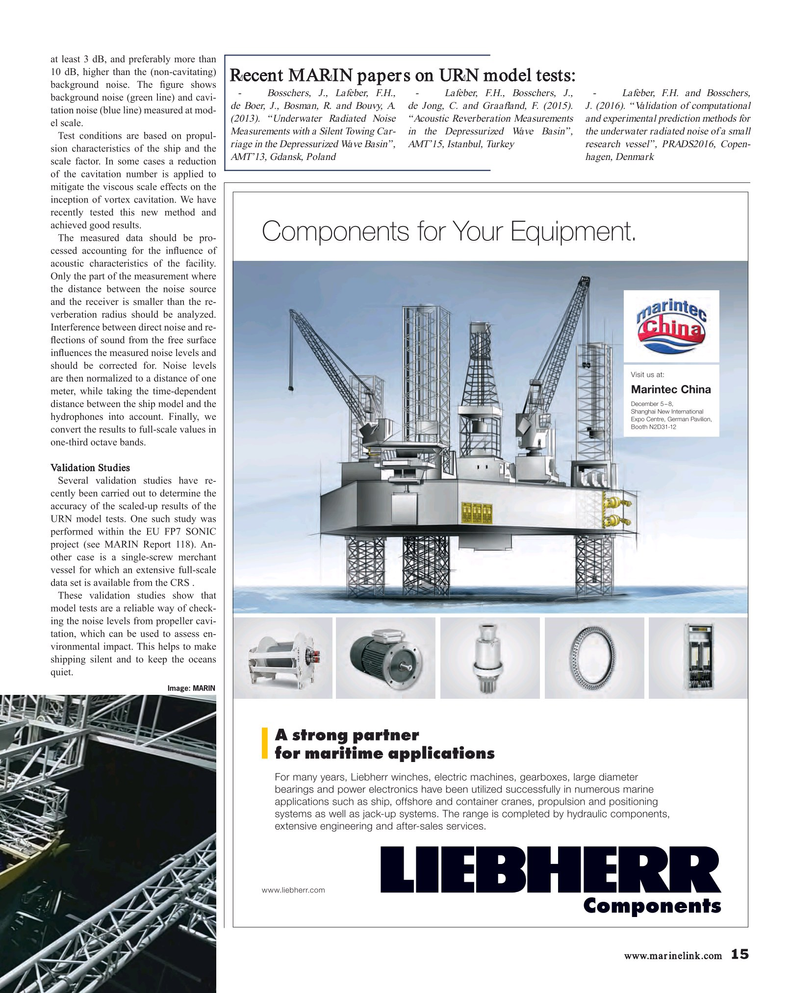
Page 15: of Maritime Reporter Magazine (October 2017)
The Marine Design Annual
Read this page in Pdf, Flash or Html5 edition of October 2017 Maritime Reporter Magazine
at least 3 dB, and preferably more than 10 dB, higher than the (non-cavitating)
Recent MARIN papers on URN model tests: background noise. The ? gure shows - Bosschers, J., Lafeber, F.H., - Lafeber, F.H., Bosschers, J., - Lafeber, F.H. and Bosschers, background noise (green line) and cavi- de Boer, J., Bosman, R. and Bouvy, A. de Jong, C. and Graa? and, F. (2015). J. (2016). “Validation of computational tation noise (blue line) measured at mod- (2013). “Underwater Radiated Noise “Acoustic Reverberation Measurements and experimental prediction methods for el scale.
Measurements with a Silent Towing Car- in the Depressurized Wave Basin”, the underwater radiated noise of a small
Test conditions are based on propul- riage in the Depressurized Wave Basin”, AMT’15, Istanbul, Turkey research vessel”, PRADS2016, Copen- sion characteristics of the ship and the
AMT’13, Gdansk, Poland hagen, Denmark scale factor. In some cases a reduction of the cavitation number is applied to mitigate the viscous scale effects on the inception of vortex cavitation. We have recently tested this new method and achieved good results.
Components for Your Equipment.
The measured data should be pro- cessed accounting for the in? uence of acoustic characteristics of the facility.
Only the part of the measurement where the distance between the noise source and the receiver is smaller than the re- verberation radius should be analyzed.
Interference between direct noise and re- ? ections of sound from the free surface in? uences the measured noise levels and should be corrected for. Noise levels
Visit us at: are then normalized to a distance of one
Marintec China meter, while taking the time-dependent
December 5 – 8, distance between the ship model and the
Shanghai New International hydrophones into account. Finally, we
Expo Centre, German Pavilion,
Booth N2D31-12 convert the results to full-scale values in one-third octave bands.
Validation Studies
Several validation studies have re- cently been carried out to determine the accuracy of the scaled-up results of the
URN model tests. One such study was performed within the EU FP7 SONIC project (see MARIN Report 118). An- other case is a single-screw merchant vessel for which an extensive full-scale data set is available from the CRS .
These validation studies show that model tests are a reliable way of check- ing the noise levels from propeller cavi- tation, which can be used to assess en- vironmental impact. This helps to make shipping silent and to keep the oceans quiet.
Image: MARIN
A strong partner for maritime applications
For many years, Liebherr winches, electric machines, gearboxes, large diameter bearings and power electronics have been utilized successfully in numerous marine applications such as ship, offshore and container cranes, propulsion and positioning systems as well as jack-up systems. The range is completed by hydraulic components, extensive engineering and after-sales services.
www.liebherr.com www.marinelink.com 15
MR #10 (10-17).indd 15 MR #10 (10-17).indd 15 10/4/2017 2:35:29 PM10/4/2017 2:35:29 PM

 14
14

 16
16
